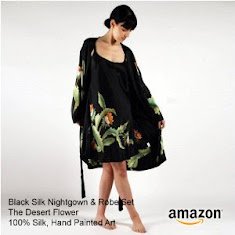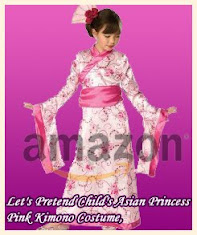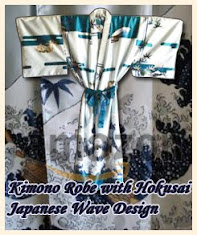History
The Japanese kimono was adopted in the 8th century A.D from the Chinese. The overlapping collar was used primarily by women. During the Heian period the kimono became increasingly fancy and a ½ apron, called a mo, was worn over it. In the Muromachi Age, the single kimono was starting to be seen without the overskirt or trousers under it. When the Edo period came to pass, the sleeves began to get longer. This was especially true for unmarried women whose sleeves sometimes will reach to the floor. The obi also got wider still and new ways of tying it came into fashion. Today's kimono is essentially unchanged from the Edo period one hundred and fifty years ago.
How is the kimono made?
The best kimonos are still made from a single bolt of silk. Today you can get a kimono made from fabric that is easier to care for such as rayon and cotton. These easier care kimono are not to be used for formal wear however and a real kimono can cost around ten thousand dollars USD. The price is well worth it as a formal kimono is made from hand-dyed silk. They are all completely hand sewn and to wash them correctly they must be taken apart.
How to wear a kimono
While traditionally the art of wearing a kimono was passed down from mother to daughter that has changed and today there are actually schools you may attend to learn to wear this difficult, yet beautiful, item of clothing.
The first step in putting on a kimono is the juban or under slip. This used to be a full kimono in its own right but most women today just wear a collar to resemble it for comfort as the juban is very hot when layered with the kimono itself.
Once you have put on the juban you will want to put on the tabi--or socks--as bending over in a kimono with the obi on is difficult. Then you will put on the kimono, making sure that the back seam is centered. You must wrap the right side over the body first as only the dead wear a kimono wrapped from the left. Then adjust the juban to show evenly around the collar. Now you will tie your obi.
The kimono is a truly lovely item of clothing steeped in history and for the Western woman, mystery. Today many women must use a professional kimono dresser to wear this outfit. I hope the art is never lost.
The Japanese kimono was adopted in the 8th century A.D from the Chinese. The overlapping collar was used primarily by women. During the Heian period the kimono became increasingly fancy and a ½ apron, called a mo, was worn over it. In the Muromachi Age, the single kimono was starting to be seen without the overskirt or trousers under it. When the Edo period came to pass, the sleeves began to get longer. This was especially true for unmarried women whose sleeves sometimes will reach to the floor. The obi also got wider still and new ways of tying it came into fashion. Today's kimono is essentially unchanged from the Edo period one hundred and fifty years ago.
How is the kimono made?
The best kimonos are still made from a single bolt of silk. Today you can get a kimono made from fabric that is easier to care for such as rayon and cotton. These easier care kimono are not to be used for formal wear however and a real kimono can cost around ten thousand dollars USD. The price is well worth it as a formal kimono is made from hand-dyed silk. They are all completely hand sewn and to wash them correctly they must be taken apart.
How to wear a kimono
While traditionally the art of wearing a kimono was passed down from mother to daughter that has changed and today there are actually schools you may attend to learn to wear this difficult, yet beautiful, item of clothing.
The first step in putting on a kimono is the juban or under slip. This used to be a full kimono in its own right but most women today just wear a collar to resemble it for comfort as the juban is very hot when layered with the kimono itself.
Once you have put on the juban you will want to put on the tabi--or socks--as bending over in a kimono with the obi on is difficult. Then you will put on the kimono, making sure that the back seam is centered. You must wrap the right side over the body first as only the dead wear a kimono wrapped from the left. Then adjust the juban to show evenly around the collar. Now you will tie your obi.
The kimono is a truly lovely item of clothing steeped in history and for the Western woman, mystery. Today many women must use a professional kimono dresser to wear this outfit. I hope the art is never lost.
06.33 |
Category: |
0
komentar

.jpg)




.jpg)
.jpg)
.jpg)
.jpg)
.jpg)
.jpg)
.jpg)
.jpg)


Comments (0)